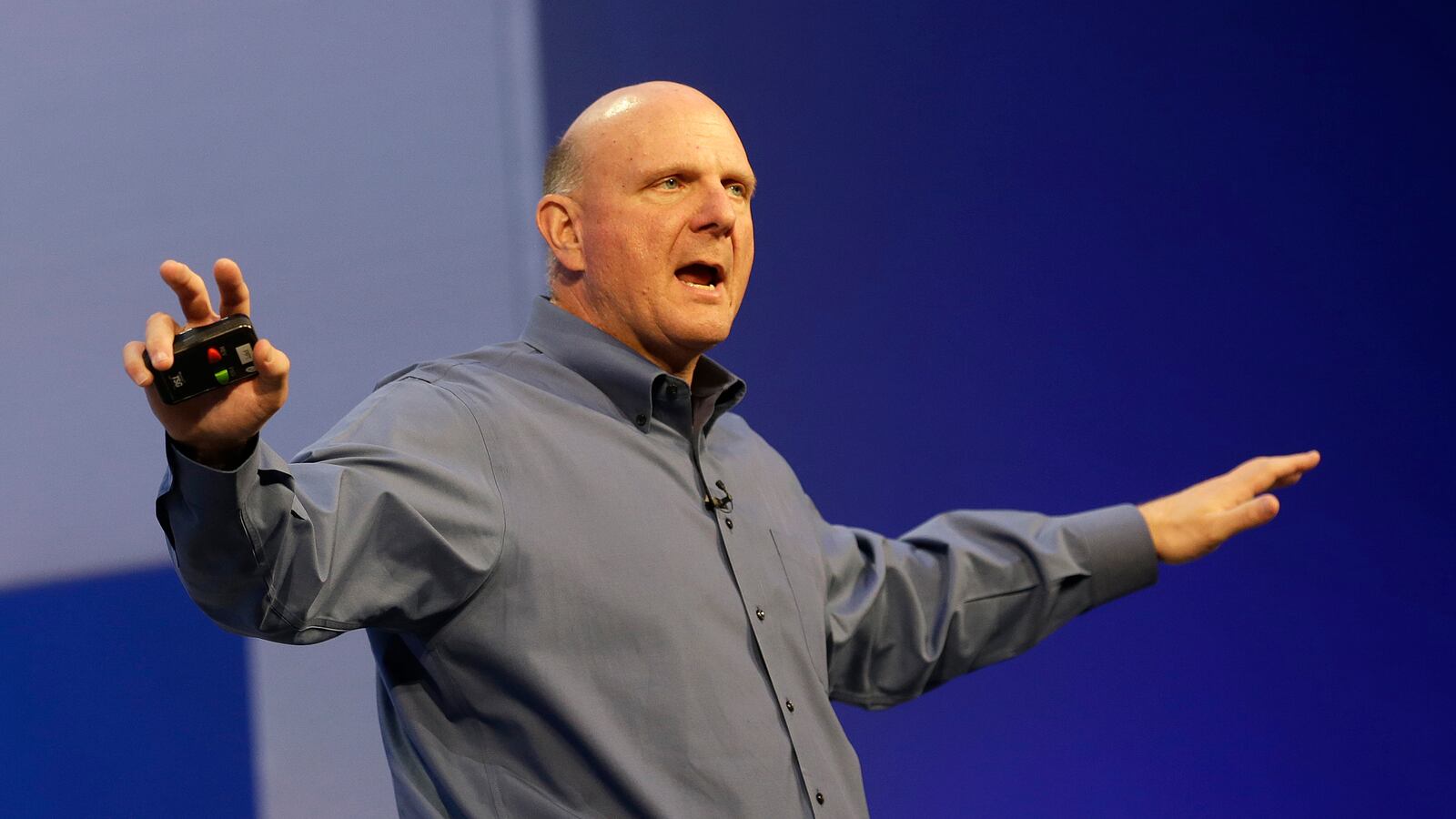It’s not remarkable that Microsoft CEO Steve Ballmer told employees Friday of his intention to resign within the next 12 months. The company has been struggling for years. What’s remarkable is how long Ballmer, who has occupied the top job at one of America’s largest companies for nearly 14 years, has managed to hold on to the post.

We live in an era of shortened attention spans and attenuated half-lives for products, companies, and business models. Yesterday’s darling is more often than not today’s fiasco and tomorrow’s footnote. World-beating companies and business models can go from hero to zero in a matter of months: MySpace, Blackberry, Groupon, Zynga.
In addition, the years of Ballmer’s reign have not been kind to technology giants that thrived in the 1980s and 1990s. The long-term chart of the tech-heavy NASDAQ Composite Index looks like the profile of an Alps stage of the Tour de France. A very sharp incline in the 1990s, peaking at about 5,000 in March 2000, then a sharp decline before a steady incline. At 3648, the NASDAQ still languishes about 25 percent below its all-time high. And it’s not just because Pets.com and Webvan stumbled. Rather, the establishment firms—multinational companies that make hardware, software, and provide services that rack up big profits—also have failed to recover. Intel traded in the mid-70s in 2000; today it’s at $22. Cisco Systems, the most valuable company in the world in March 2000, has lost 70 percent of its value. The story is similar at Hewlett-Packard, Dell, and, to a lesser degree, Microsoft. The company’s long-term stock chart shows that it peaked at about $58 in late 1999 and trades today at about $34—a decline of only 40 percent.
It’s not hard to account for these declines. Big tech in the late 1990s rose to bubble-era valuations—those stocks were vastly overpriced at the time. And in the intervening years, the continuing expansion of the Internet, insanely tough competition, the rise of the cloud and mobile, shrinking margins, and the constant creation of new competitors have changed the landscape.
It has been a great environment for upstarts, who can gain scale and find customers easily. But for companies that were thriving in the late 1990s technology-software-hardware complex, it has been harder to shift. Apple had little to lose by reinventing itself a decade ago and betting heavily on new products and services. Its market capitalization was down to a few billion dollars. But the establishment firms had much more to lose. They were minting money on their core operations. Their size meant they were vulnerable to stealthy competitors. And at Microsoft, it would be difficult—if not impossible—for any new product or set of services to rival the core business. Whatever Microsoft did—investing in MSN, the Zune, MSNBC, Internet Explorer, tablets, or gaming—would always pale in comparison to the core operating system and software business.
Time and again, CEOs of giant firms have been upended by change. So 13 years is something like an eternity in the technology world and in the business world generally. Keep in mind that when Ballmer took office, Bill Clinton was still president, Apple was an also-ran PC maker, Google was less than two years old, and Mark Zuckerberg was 15.
According to the Conference Board, in 2012 53 of the CEOs of the companies in the Standard & Poor’s 500 left their posts. That’s about average for the past decade, which makes the typical tenure as CEO about eight years. According to The Wall Street Journal, the average tenure of the CEO of a Fortune 500 company is 4.6 years. The life of a big-time CEO isn’t quite Hobbesian—nasty, brutish, and short. More like fantastically well paying, brutal hours, and comparatively short.
But the irony of this gilded age is that the reigns of imperial CEOs can be quite short. Especially on the West Coast. Since 2000, Hewlett-Packard has had six chief executive officers. If you count interim CEOs, Yahoo! has gone through a half-dozen top bosses in the past decade. Paul Otellini, who stepped down as CEO of Intel, lasted eight years in the top post.
Investors have long since soured on Ballmer. It has been clear that the combative, enthusiastic, longtime Gates lieutenant, who had a background in consumer products, was not the guy who could deliver out-of-the-box technology solutions. Nor would he be the guy who would take drastic, perhaps necessary action to change the shape of the company—spinning off units, shutting down others, splitting up the company. In recorded history, few emperors have voluntarily sought to reduce the size of their empires.
But while Microsoft hasn’t exactly been a success story over the past several years, it hasn’t imploded, as so many other well-known firms have. The company pays a dividend, buys back its stock, earns profits, employs lots of people, and continues to introduce products that lots of people seem to want to buy. In other words, Ballmer didn’t destroy the value inherent at the firm. And his stewardship helps explain the odd phenomenon in the market Friday morning. The Microsoft-Ballmer split may be the rare case in which an amicable divorce leaves both parties richer.
After the announcement, Microsoft’s stock surged about 8 percent, adding about $20 billion to Microsoft’s market capitalization. Why? Investors believe that Ballmer’s replacement will do a better job mining value out of the company’s substantial assets and market position. Meanwhile, Ballmer, who owns about 333 million shares in the company, saw his stake rise in value by $769 million. Talk about a golden parachute.






